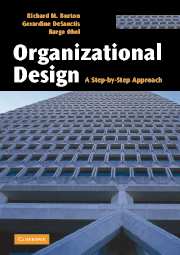Book contents
- Frontmatter
- Contents
- List of figures
- List of tables
- Preface
- An outline of the step-by-step approach
- Step 1 Getting started
- Step 2 Strategy
- Step 3 Structure
- Step 4 Process and people
- Step 5 Coordination and Control
- Applying the step-by-step approach in a dynamic world
- 11 Design dynamics: managing change and multi-organizations
- References
- Index
11 - Design dynamics: managing change and multi-organizations
- Frontmatter
- Contents
- List of figures
- List of tables
- Preface
- An outline of the step-by-step approach
- Step 1 Getting started
- Step 2 Strategy
- Step 3 Structure
- Step 4 Process and people
- Step 5 Coordination and Control
- Applying the step-by-step approach in a dynamic world
- 11 Design dynamics: managing change and multi-organizations
- References
- Index
Summary
Introduction
In this book, we have developed a step-by-step approach to organizational design, focusing on analysis of an existing organization and identification of misfits among organizational design components. We have outlined a way to diagnose whether a firm has strategic organizational design misfits and considered what you might change to align the basic design components so as to fix misfits and meet organizational goals. In this final chapter we address what to change and why. It is a summary of the design process with special attention to the question, what aspects of your organization should be changed? First, we will briefly restate the step-by-step approach and then we will examine the change process in more detail. Finally, we will discuss more complex design situations, that is, multi-organizations, including joint ventures, mergers, and strategic alliances/partnerships.
Where are you in the step-by-step approach?
If you have systematically followed the steps outlined in Chapters 1through 10, then you have completed the step-by-step approach for your chosen firm. You have followed each step below by, first, assessing your firm's current organizational design; second, identifying misfits (i.e., detecting components that are not well aligned to meet organizational goals); and, third, deciding what you might do to either bring the design components into the same quadrant of the organizational design space or tolerate the misfits.
- Type
- Chapter
- Information
- Organizational DesignA Step-by-Step Approach, pp. 203 - 224Publisher: Cambridge University PressPrint publication year: 2006



